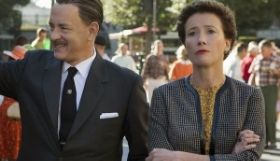 So here’s a question for you: can Emma Thompson do any wrong?
So here’s a question for you: can Emma Thompson do any wrong?
Don’t worry too much about the answer because it’s no. Proof positive is her latest film, Saving Mr. Banks, a movie she makes so enjoyable simply by being, well, her. And, in the process, she makes Tom Hanks, who’s having a career year, look almost ordinary. And you thought Judi Dench had mad skills.
In Saving Mr. Banks, Thompson plays P.L. Travers, the author of the popular book “Mary Poppins”, who reluctantly travels to Burbank, California in 1961 to meet with Walt Disney, played by Hanks, who wants Travers to sign the rights of her book over to him, so his studio may proceed with its planned film adaptation of it. Winning her over turns out to be a mighty task however, even for the charming and famous studio head, as Travers refuses to give up any control of how her story is portrayed and demands final say in all aspects of the film before she will sign over the rights. The result is Travers being allowed to sit in on all rehearsals and read-throughs of the script by screenwriter Don DaGradi (Bradley Whitford), and songwriters Robert and Richard Sherman (B.J. Novak and Jason Schwartzman). These rehearsal scenes are by far the highlights of the movie, especially for fans of the movie Mary Poppins, as we get to see scenes of the movie acted out, and ideas tossed in or out, depending on whether Travers originally liked them or not. There are tapes of these sessions, so I imagine a lot of these scenes are based on reality. Any fan of Mary Poppins must see this movie—it’s almost like a making-of documentary come to life.
Unfortunately, where the movie bogs down is when the director, John Lee Hancock (The Blind Side) tries to infuse a depth of character to Travers by giving us flashbacks to her childhood in Australia, a childhood which helps to color the woman she is and, more important, is designed to help us understand the impetus behind the writing of “Mary Poppins” and the personal attachment she has to the character and her reluctance to giving up control of how the story is portrayed. Sadly, though, these flashback sequences are too unimaginative and predictable, and only serve to weigh the movie down. But every time we come back to Burbank, the energy returns and the movie starts to crackle again. Hanks is his usual charming and likeable self as Disney, but it also is just a bit too predictable as I found myself wishing he had colored the character just a bit more. Paul Giamatti makes a nice appearance as Travers’ driver who becomes her friend.
But make no mistake, Saving Mr. Banks is a movie to be seen for Emma Thompson. She takes a character that could otherwise really be a cartoon and infuses her with real depth. This character, on the page, is wholly unlikeable and cold, yet in Thompson, there is a real compassion and humanity that comes through—she is able to make us understand who this woman is and tells us why we should care about her even though everything out of her mouth contradicts exactly that. I don’t know how else to say it other than it is a thorough pleasure to watch Emma Thompson in this role and in this movie. Go see Saving Mr. Banks and savor it.
